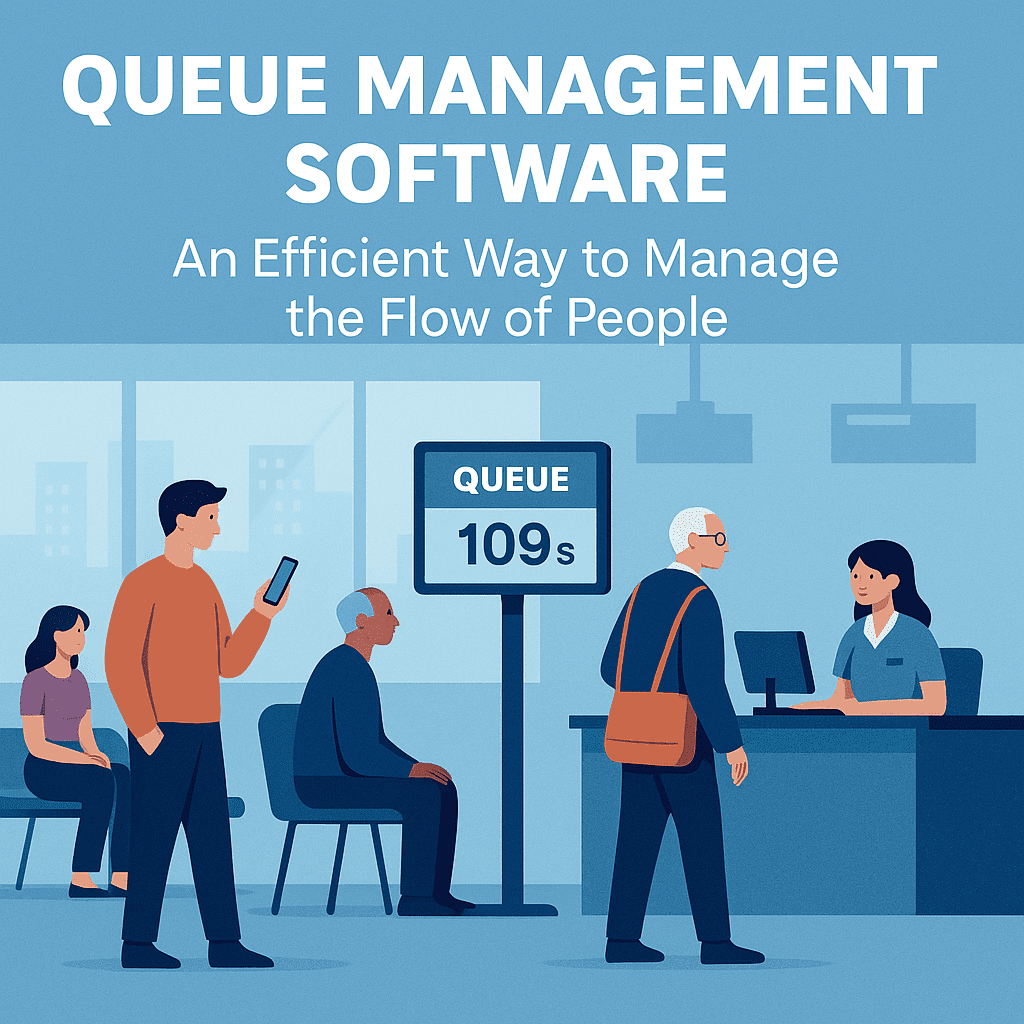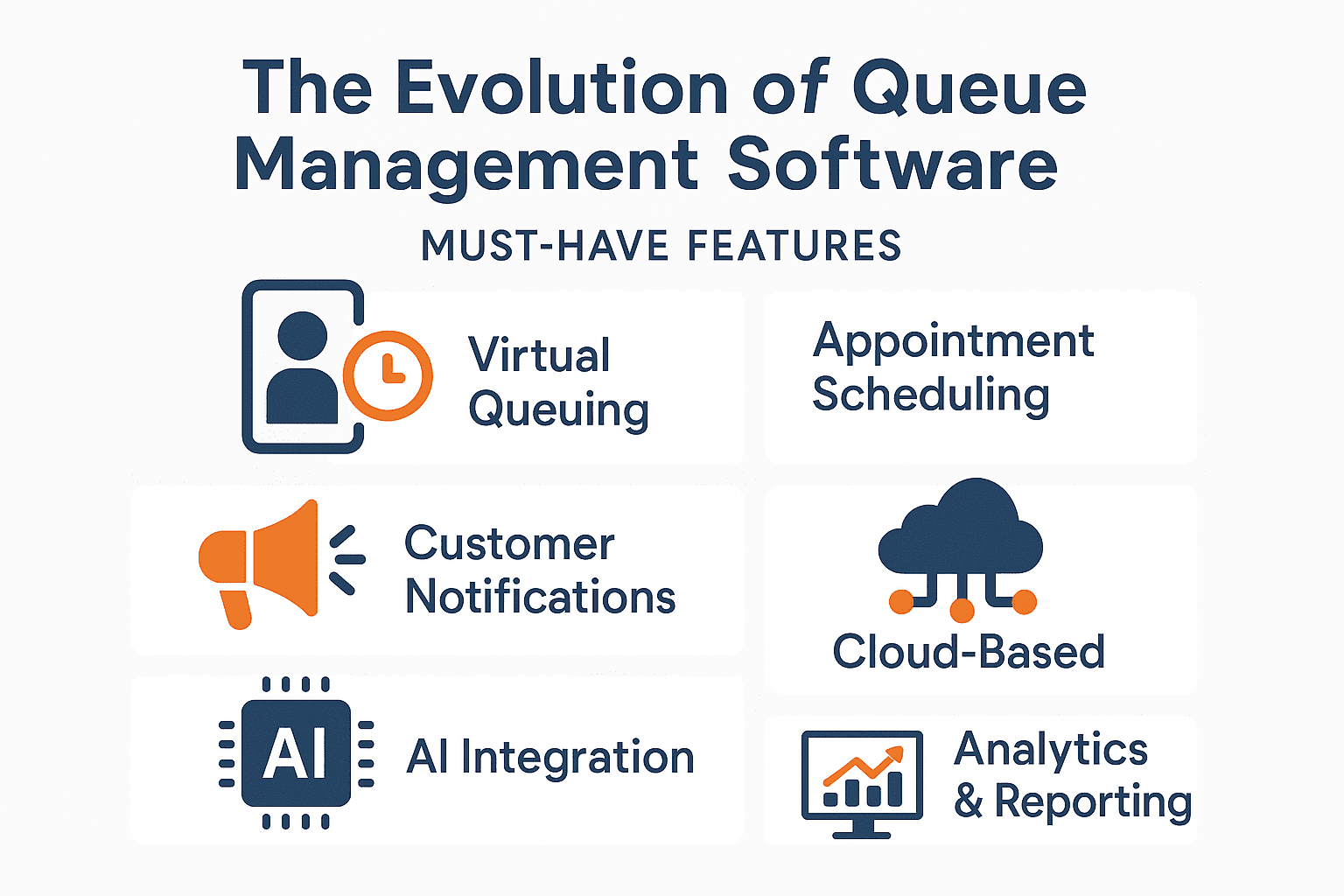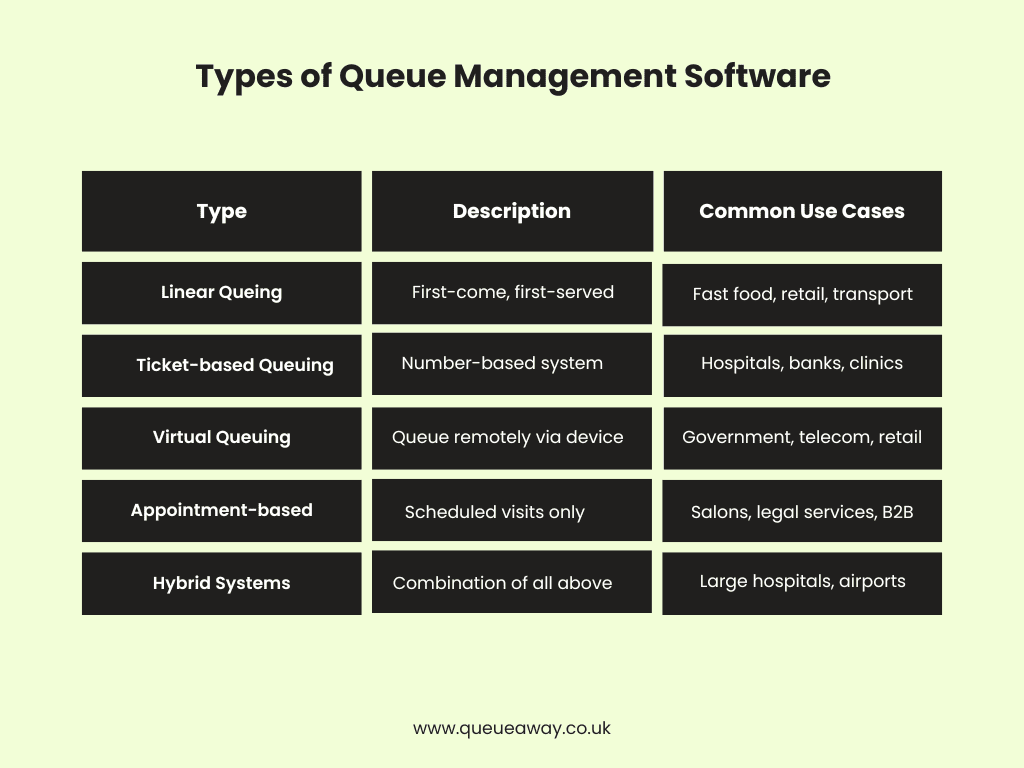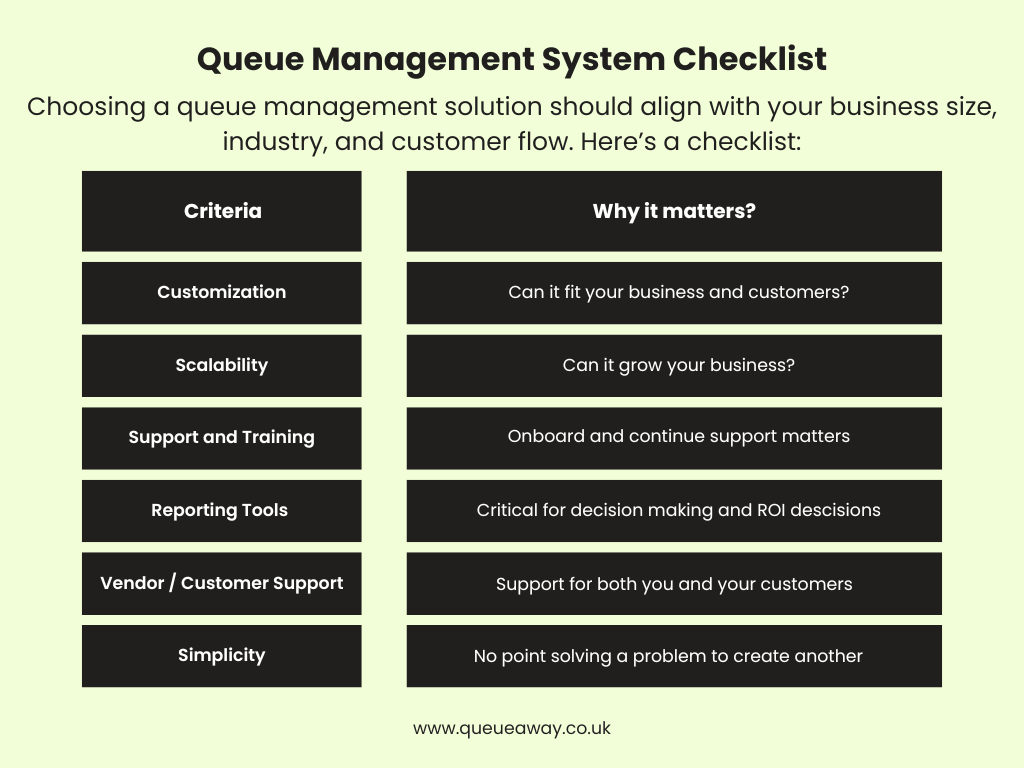Queue Management Software USA: Features, Benefits & 2025 Market Trends

Why You Need an App for Queue Management Software – QueueAway OverviewQueue Management Software
In today's dynamic environment, managing customer queues efficiently is more crucial than ever for small businesses. Long waits and disorganized crowd management can significantly hamper customer satisfaction and operational performance. Queue management software provides an innovative approach to streamline operations, ensuring seamless interactions for both customers and businesses.
This article examines the essential features that make queue management software vital, including virtual queuing, appointment scheduling, real-time updates, and self-service check-ins. By adopting these solutions, organizations can enhance the customer experience, reduce wait times, and optimize operational efficiency.
We'll explore how various industries like healthcare, retail, and banking leverage these systems and offer insights into selecting the right software. Additionally, we will highlight leading options on the market, compare free and paid solutions, and discuss emerging trends in queue management technology.
Key Features of Queue Management Software
Queue management software is a powerful tool designed to optimize and streamline the customer flow experience. It offers a scalable and flexible solution that evolves alongside business needs, ensuring cost efficiency and operational scalability, especially as businesses expand to new locations. The software provides real-time customer data and operational insights, empowering businesses to optimize staffing, eliminate bottlenecks, and enhance customer experiences. Highly configurable, it allows businesses to tailor solutions without vendor intervention, thus boosting customer engagement and satisfaction. By integrating advanced analytics and reporting tools, queue management software enables organizations to collect and analyze performance data, facilitating continuous improvement and informed, data-driven decisions. Automation, including host alert notifications and post-visit communication, further increases operational efficiency by reducing manual tasks and helping gather valuable customer feedback.
According to Statista, global customer experience management (CXM) software revenue reached $12.04 million in 2023, with queue management systems making up a growing portion due to increased demand for smarter, digital-first service solutions, with The global queue management system market is projected to reach USD 1.20 billion by 2032, growing at a CAGR of 6.31% from 2024 to 2032, indicating a significant rise in demand for efficient customer flow solutions.
3. Key Features of Effective Queue Management Software

Must-Have Features in an App for Queue Management Software
The evolution and essential features of an app for queue management software, highlighting tools like virtual queuing, AI integration, and real-time analytics for enhanced customer experience.
Virtual Queuing
Virtual queuing revolutionizes the waiting experience by allowing customers to join a queue without physically standing in line. This flexibility offers customers the choice to wait wherever they prefer. The system supports several check-in methods, such as QR codes, SMS, WhatsApp, on-site tablets, or kiosks, enhancing accessibility. Customers receive real-time notifications about their queue position, improving the waiting experience by keeping them informed. Staff can efficiently view and manage customer queues via any web browser-supported device, ensuring robust service interfaces. Virtual queuing solutions also include features like automated notifications and appointment scheduling, which help balance customer flow and reduce congestion in service lines.
Appointment Scheduling
Appointment scheduling integrated with queue management systems simplifies the booking process and reduces administrative burdens. Patients, for instance, can make online bookings and receive confirmations and reminders, streamlining the healthcare staff's workload. This system is applicable to various departments, including registrars and information desks, where appointment tracking and insights are crucial. Public check-in systems and real-time updates offered by some queue management solutions ensure efficient visitor management, accommodating high-traffic areas by blending digital queuing with appointment solutions. These cloud-based platforms provide functionalities such as online waitlists, reminders, and management dashboards, enhancing customer intake processes and contributing to shorter wait times.
Real-Time Updates
Real-time updates are a crucial component of queue management systems, providing transparency and enhancing the customer waiting experience. Customers receive continuous information about their queue position and estimated wait time through SMS, email, or mobile notifications, allowing them to manage their time effectively. This real-time communication adds a human touch, which fosters better customer engagement and satisfaction. An online queue page can also keep customers informed about changes in services or product statuses, leading to an improved waiting experience. Additionally, real-time data capture allows businesses to analyze metrics like service demand and waiting patterns, facilitating process improvements and efficient service delivery.
Dynamic Digital Signage
Dynamic digital signage adds a crucial dimension to queue management by displaying real-time queue information, helping customers manage their time effectively. This technological integration ensures seamless communication of waiting details, such as the current serving number and service counter. Businesses can also use digital signage to stream tailored marketing content to the profiles of queuing customers, enhancing their engagement and perception of wait times. Furthermore, digital signage can entertain waiting customers with engaging media, improving their overall experience. By enhancing transparency and managing customer expectations, dynamic digital signage plays a vital role in elevating customer satisfaction.
Self-Service Check-Ins
Self-service check-ins streamline the customer intake process, offering a convenient way for customers to check-in without staff assistance. Available through kiosks, mobile devices, or websites, self-service check-ins allow businesses to efficiently manage customer flow. Transforming devices like iPads into kiosks provides a multilingual interface, catering to diverse customer needs and enhancing engagement. Plus, these kiosks can display a business's branding elements, strengthening brand consistency. By integrating with virtual queue systems, customers benefit from real-time updates about their wait times, significantly reducing perceived wait time and enriching the customer journey.
Analytics and Reporting Tools
Analytics and reporting tools embedded in queue management systems provide actionable insights that drive operational efficiency and customer satisfaction. These solutions facilitate quick data gathering, enabling organizations to respond promptly to audit requirements. Thanks to their cloud-based nature, these systems easily aggregate data across multiple locations, offering a comprehensive view. Customized to meet specific business needs, these tools do not typically require vendor support, thus promoting autonomy. By leveraging real-time data and insights, businesses can streamline operations, increase efficiency, and reduce costs, all while ensuring an improved waiting experience for customers.

Comparison chart of queue management system types including linear queuing, ticket-based queuing, virtual queuing, appointment-based, and hybrid systems, with descriptions and industry use cases such as retail, healthcare, government, and airports
Why Queue Management Matters here in the U.S.
Unmanaged queues don’t just frustrate customers—they cost businesses money. A study found that 75% of customers are not willing to wait more than five minutes in a queue before abandoning the service. Even worse, 89% of customers who experience a poor wait experience are less likely to return.
Let’s look at some numbers:
U.S. businesses lose $62 billion/year due to poor customer service (Forbes).
Average wait time in retail stores: 6.5 minutes (Retail Dive).
Reduction in wait times by even 20% can increase customer retention by 35%.
Queue management software addresses these issues head-on by:
Predicting and managing wait times.
Allocating staff efficiently.
Offering virtual queue options.
Improving transparency.
Applications Across Industries
Queue management software is revolutionizing how industries handle customer interactions and manage service flows. By replacing traditional physical lines with a dynamic virtual system, organizations can significantly reduce wait times and enhance overall customer experience. These systems provide real-time updates and capture data-driven insights into consumer behavior, preferences, and peak service times, enabling more informed decision-making and operational efficiency. With scalable solutions, businesses can easily accommodate growth and expansion without compromising the quality of customer service. This is achieved by aligning customer requests with the staff most suited for the task, ensuring personalized and high-quality service. Automation in assigning visitors to appropriate services further streamlines operations, cuts down overcrowded waiting areas, and amplifies customer experiences across various sectors.
Healthcare Sector
In the healthcare sector, implementing smart queue management software can drastically streamline processes like patient check-ins and check-outs. By directing patients promptly to the appropriate departments, these systems enhance the entire care process, reducing waiting room congestion and cutting down on potential health risks associated with crowded areas. Moreover, when combined with appointment scheduling tools, queue management systems alleviate administrative workload, facilitating easy online bookings and sending automatic reminders to patients. Results from deployed solutions indicate substantial improvements in patient journey management, as these technologies optimize patient flows and ensure faster service delivery, ultimately boosting both patient satisfaction and healthcare provider efficiency. The adoption of such systems reflects a proactive approach to enhancing healthcare operations and patient experiences.
Retail Industry
The retail industry is utilizing queue management software to enhance customer experiences by aligning services with evolving consumer demands. These systems offer real-time data on customer flow, which aids in understanding consumer behavior and peak shopping times. Retailers can then tailor their service offerings and staffing to match customer demand, ensuring efficient and personal service delivery. Mobile queuing capabilities allow customers to manage their shopping experience through their devices, enhancing convenience. Additionally, queue management software facilitates effective staff planning by providing insights into staff performance and visitor volumes. The segmentation of customers into service lines based on staff expertise also optimizes service quality. This level of personalization not only enhances customer satisfaction but also fosters customer loyalty in a competitive marketplace.
Banking and Financial Services
Queue management software offers a cost-effective strategy for managing customer flows within banking and financial institutions. By optimizing customer routing and service allocation, it significantly boosts productivity among sales teams while reducing the necessity for additional staffing. Real-time data regarding visitor volumes and staff efficiency empowers banks to enhance operational management and staff performance. Additionally, these systems can substantially decrease customer wait times, leading to a directly enhanced experience. As operations become more streamlined and service delivery optimized, banks also see an uptick in overall sales performance. Implementing queue management solutions allows financial institutions to navigate their customer service challenges efficiently, ensuring they maintain competitive edges through improved service and customer satisfaction.
U.S Emerging Trends in Queue Management Systems and Software
The global queue management system market is booming. Here's a snapshot of the growth trajectory:
The North American queue management system market is projected to grow at a CAGR of 5.6% from 2024 to 2031, with the U.S. market expected to reach $321 million by 2031. souce KBV reseaarch
The global queue management system market was valued at USD 0.70 billion in 2023 and is projected to reach USD 1.20 billion by 2032, growing at a CAGR of 6.31% from 2024 to 2032 . source GlobeNewswire
Projected Market Size in 2030: $1.12 billion
CAGR: 8.3% (2023–2030)
Key Growth Drivers:
Rising demand for digital transformation.
Increased customer expectations post-pandemic.
Cloud-based deployment and mobile integrations.
Surge in footfall at service centers post-COVID.
Regional Trends:
North America: Largest market, early tech adoption.
Europe: Focus on healthcare and banking.
Asia-Pacific: Fastest-growing due to urbanization and digital government services.
Case Studies & Success Stories
a) Kaiser Permanente
Healthcare providers such as Kaiser Permanente utilize appointment scheduling and queue management software to streamline patient flow.
b) Emirates NBD – Banking Transformation
By integrating QMS with CRM, Emirates NBD saw a 35% drop in walk-out rates and improved NPS scores significantly.
c) Walmart – Retail Optimization
Walmart used predictive queueing algorithms to assign staff dynamically, improving checkout speed by 32%.
d) Target and Best Buy
Retail chains like Target and Best Buy have adopted virtual queuing systems to enhance customer experience during peak shopping seasons.
Factors to Consider When Choosing a Queue Management System
Choosing the right queue management system (QMS) is crucial for any organization looking to enhance its customer service and operational efficiency. These systems are designed to streamline the customer flow, minimize wait times, and improve overall service delivery. When evaluating potential solutions, consider the unique queuing challenges your organization faces, the workflows in place, and the volume of customer traffic handled daily. Customization and scalability are also key factors; the system should be able to grow and adapt alongside your business. Compatibility with existing IT infrastructure ensures seamless integration, while user-friendliness for both staff and customers can significantly improve the queuing experience. Additionally, features such as real-time monitoring and detailed analytics are vital for making data-driven decisions and refining operational processes.

Checklist for selecting a queue management system app, including criteria like customization, scalability, support and training, reporting tools, vendor support, and simplicity—each explained with its importance for business success.
Integration Capabilities
Integration capabilities in queue management systems play a pivotal role in optimizing business operations by enhancing communication and collaboration. Advanced QMS solutions can integrate with platforms like Twilio and Salesforce, boosting their functionality considerably. In particular, government and banking sectors benefit from tools like Q-Flow, which streamline operations through seamless integrations. Solutions such as monday service enhance flexibility by allowing integrations with popular apps like Slack, Google Drive, and Jira. By enabling these connections, queue management systems can deliver omnichannel solutions, ensuring that diverse modules work in harmony for smooth business operations. This interconnected approach helps businesses offer more cohesive and responsive customer service.
Cost-Effectiveness
Cost-effectiveness is a compelling reason to implement queue management software. By automating routine tasks and reducing operational inefficiencies, businesses can streamline processes, potentially lowering costs. As businesses grow, scalable QMS solutions help minimize expenses by efficiently adapting to new demands, particularly when expanding to new locations. Enhanced customer experiences achieved through reduced wait times often lead to increased sales and a higher return on investment. Virtual queue management tools provide real-time data and analytics to optimize staffing and remove bottlenecks, creating additional cost savings. Moreover, improvements in staff performance and customer retention can diminish expenses related to customer dissatisfaction, enhancing the financial benefits of the system.
Customization and Flexibility
Customization and flexibility are key strengths of sophisticated queue management systems like QueueAway Queue Management. This software offers a configurable system that allows significant adjustments without requiring vendor support, thanks to its intuitive user interface. Businesses can tailor the software to include features such as click and collect or buy online, pick up in store, enhancing the queuing process to better suit their specific needs. A scalable QMS can support company growth by effectively reducing costs as new locations are added. The ideal system should empower businesses to personalize their customer service through a robust set of features, efficiently optimizing service delivery. By incorporating various service modules, a flexible queue management system ensures personalized customer interactions, significantly enhancing customer satisfaction and loyalty.
Leading Queue Management Systems in the Market
Queue management systems have become essential for businesses seeking to enhance customer service and streamline operations. Leading solutions in the market today are not just about managing physical lines but have evolved to offer a range of features that improve customer experiences and overall service delivery. These systems incorporate real-time data and analytics, virtual queuing, and self-service options to create a seamless customer journey. Key players in this space, such as QueueAway and Greetly, provide highly configurable solutions tailored to specific business needs. These advanced systems help reduce average wait times and optimize staff performance, ultimately working towards better customer loyalty and satisfaction.

App for Queue Management Software in Action
An app for queue management software, highlighting virtual queuing with a mobile interface that enhances customer convenience and reduces wait times.
Overview of QueueAway
QueueAway is an intuitive queue management system app purpose-built to eliminate the frustration of waiting in physical lines. Designed with modern businesses in mind, QueueAway combines simplicity with powerful functionality to optimize customer flow, streamline operations, and elevate the overall service experience. Whether used in retail, healthcare, government offices, or hospitality, QueueAway helps organizations handle in-person and virtual queues with equal efficiency. By replacing traditional queues with virtual waiting rooms, QueueAway reduces perceived wait times and improves customer satisfaction. Its intelligent scheduling and load-balancing features allow for smarter staff allocation and smoother service delivery. Businesses using QueueAway report up to 60% shorter queues and a noticeable uptick in operational productivity and customer happiness.
Features of QueueAway
QueueAway’s queue management system app is packed with smart, user-centric features that benefit both customers and businesses:
Contactless check-ins via QR codes, SMS links, or web-based self-check-in pages
Real-time queue tracking that allows customers to monitor wait times remotely
Automated notifications (SMS, email, and app push) to alert users when it’s nearly their turn
Smart scheduling and appointment booking integration
Multi-location support for franchises and enterprise-level businesses
Custom branding options to keep the customer journey consistent
Data and analytics dashboard that highlights KPIs, wait time trends, and peak periods
Accessibility-first design with multilingual support and screen reader compatibility
Advantages of QueueAway
QueueAway stands out for its quick deployment, ease of use, and high configurability. Unlike legacy systems, QueueAway operates as a cloud-first, no-hardware-required platform that can be up and running in minutes. Businesses can tailor queue settings without any technical background, thanks to its intuitive admin dashboard. QueueAway integrates easily with booking systems, CRMs, and other customer engagement tools, enabling seamless data sharing and reporting. Its virtual queuing system empowers customers to wait from wherever they feel most comfortable—whether that’s their car, a nearby café, or at home. With a sharp focus on reducing walkouts and wait-related complaints, QueueAway ensures smoother service flow, better customer retention, and a more positive brand perception.
Overview of Qminder
Qminder stands out with its robust queue management system that aims to transform customer service experiences into actionable insights. This platform excels in organizing waitlists, reallocating customers, and managing service lines, thus catering to businesses of all sizes across diverse industries. Qminder’s emphasis on analytics facilitates data-driven decision-making, allowing businesses to track KPIs, evaluate team performance, and understand customer visit patterns. The system’s standout features include self-check-in kiosks, real-time appointment scheduling, automated notifications, and a multilingual interface. By focusing on reducing wait times by up to 50% and decreasing no-show rates significantly, Qminder can enhance customer satisfaction by up to 97%, providing a comprehensive solution for effective queue management.
Features of Wavetec
Wavetec delivers a comprehensive queue management solution designed to streamline customer flow and improve operational efficiency. This system supports mobile, virtual, and in-person queues, enabling businesses to handle customer interactions effortlessly through a unified platform. One of Wavetec's key features is virtual queuing, which integrates seamlessly with popular messaging apps like WhatsApp, allowing customers to join queues remotely. This enhances convenience and accessibility, making the queuing process smoother for everyone involved. Wavetec also offers digital signage, ticket printers, and self-service kiosks, which inform customers of their wait times and guide them through the service process. Additionally, the system's integration capabilities with various CRM and ERP systems empower businesses to combine customer data with real-time queue insights, offering a more personalized and efficient service delivery.
Advantages of Qtrac
Qtrac's queue management software offers a flexible, browser-based system that is accessible from any location. It allows users to check in via QR codes, SMS, and on-site kiosks, removing the need for a dedicated app and making it convenient for both operators and customers. The platform's cloud-based nature ensures ease of access and deployment, supported by its no-code interface that simplifies implementation. Over 5,000 locations globally trust Qtrac for its user-friendly booking system that customers can access via websites and smartphones. This capability empowers customers to join queues from anywhere, giving them more control over how they spend their time and reducing the necessity for physical lineups. With features to prioritize, requeue, transfer, edit, or delete waitlist entries, Qtrac optimizes queue efficiency and enhances the customer waiting experience significantly.
Comparing Free vs. Paid Options
Choosing between free and paid queue management software is crucial for businesses striving to enhance their service delivery and improve customer experiences. Free versions generally come under a freemium model that includes only basic features suitable for simple queuing processes. These free solutions are often designed for small businesses or startups needing to manage customer flow with limited resources. However, the allure of free software should be balanced with a thorough evaluation of features to ensure they align with the business’s specific needs.
On the other hand, paid options typically offer more advanced functionalities geared toward larger-scale operations. These solutions often cater to businesses with complex requirements, providing tools for detailed analytics, real-time updates, and comprehensive reporting. Affordable options like Qsome and Qwaiting provide robust features without breaking the bank, whereas more sophisticated alternatives, such as Verint and Qmatic, offer premium capabilities at a higher price point. To navigate this choice effectively, businesses can take advantage of trial periods offered by many providers to test the software before making a financial commitment.
Basic Features in Free Packages
Free queue management systems generally provide a basic framework suitable for managing simple customer interactions. These solutions, typically offered under a freemium model, are ideal for businesses with straightforward needs—such as small retailers and specific service providers. For instance, QueueAway comes with free versions that are especially appealing to smaller operations due to their simplified functionality.
However, free versions often lack the advanced capabilities needed for intricate service delivery scenarios. Features may be limited to fundamental aspects such as customer wait time tracking, basic real-time data as it pertains to physical lines, and simple queuing processes. Therefore, it is important for businesses to closely examine these features to determine if they meet existing operational demands before proceeding with full integration. For those with growing or more complex needs, an upgrade to a paid solution might be necessary to achieve the desired efficiency and customer satisfaction.
Advanced Capabilities in Enterprise Solutions
Enterprise queue management solutions deliver a wealth of advanced capabilities designed to meet the needs of larger organizations with complex service delivery requirements. These systems offer a high degree of configurability, allowing businesses to tailor the software to their specific operational dynamics. This adaptability enables organizations to implement personalized services and optimize customer flow by efficiently matching visitor requests with the most qualified staff.
Such solutions also offer extensive real-time data tracking, providing insights into staff performance and visitor volumes. This real-time information is crucial for managers to effectively plan and allocate resources during peak service times, thereby enhancing the overall customer journey. Furthermore, cloud-based enterprise solutions simplify compliance and audits by quickly providing comprehensive queue data across multiple locations, making them highly scalable and flexible for expanding businesses. These features are vital as organizations grow, allowing for a seamless integration when opening new locations without incurring additional costs.
Future Trends in Queue Management Technology
As queue management technology evolves, virtual solutions are taking center stage, featuring innovations like online appointment booking to boost customer service efficiency and satisfaction. Modern systems are increasingly equipped with tools that manage customer expectations by providing real-time updates on wait times and service processes. This approach significantly cuts down on walkouts and enhances customer retention.
Emerging technologies like AI-driven personalization and sentiment analytics are revolutionizing customer experience strategies in 2024. Rorbes reports on the 10 most important customer experience trends for 2024.
Scalability is becoming paramount, designed to meet expanding organizational demands. Future systems will likely incorporate robust integration capabilities, allowing seamless cooperation with existing hardware and processes to streamline operations effectively. In addition, multi-lingual support is emerging as an essential feature, enabling customers to interact comfortably in their preferred language, thereby enhancing their overall queuing experience.
Key Future Features in Queue Management:
Virtual Queuing: Transition to online appointment systems.
Real-time Data: Live updates on wait and service times.
Scalability: Adaptable to growing organizational needs.
Integration Capabilities: Compatible with current systems.
Multi-lingual Support: Enhances inclusivity and accessibility.
These advancements promise not only shorter wait times but also significantly improve customer journeys, leading to enhanced customer loyalty and experiences across various service lines.
Case Studies & Success Stories
a) Kaiser Permanente
Healthcare providers such as Kaiser Permanente utilize appointment scheduling and queue management software to streamline patient flow.
b) Emirates NBD – Banking Transformation
By integrating QMS with CRM, Emirates NBD saw a 35% drop in walk-out rates and improved NPS scores significantly.
c) Walmart – Retail Optimization
Walmart used predictive queueing algorithms to assign staff dynamically, improving checkout speed by 32%.
d) Target and Best Buy
Retail chains like Target and Best Buy have adopted virtual queuing systems to enhance customer experience during peak shopping seasons.
Get Started with QueueAway Today
Whether you’re in healthcare, retail, finance, or government services, QueueAway delivers the tools to manage customer flow with precision.
Book a free demo and discover how our queue management system can transform your business today.
Related Links:
Frequently Asked Questions
Q1: What is queue management software, and why is it important?
Queue management software (QMS) refers to digital solutions designed to streamline the customer waiting process, reduce wait times, enhance operational efficiency, and ultimately improve customer satisfaction. It's essential for businesses aiming to improve service delivery and customer experience.
Q2: What are the key features of modern queue management systems?
Modern QMS platforms offer features such as virtual queuing, appointment scheduling, real-time notifications, analytics dashboards, and integration capabilities with other business systems.
Q3: Which industries benefit most from using queue management software?
Industries like healthcare, retail, banking, government services, and education benefit significantly from QMS by improving service efficiency and customer satisfaction.
Q4: What are the current trends in queue management software?
Current trends include the adoption of AI-driven analytics, cloud-based solutions, mobile integration, and personalized customer experiences.
Q5: How is the queue management system market expected to grow?
The global queue management system market size was estimated at USD 793.8 million in 2023 and is projected to grow at a CAGR of 6.4% from 2024 to 2030.


